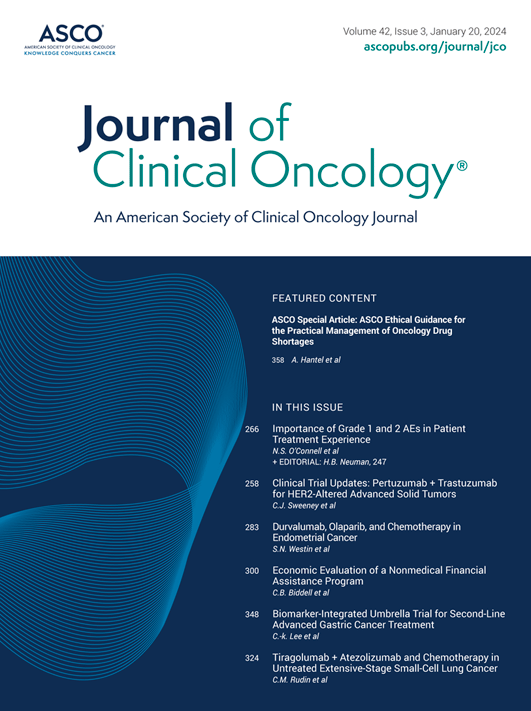Addition of Carboplatin to Sequential Taxane-Anthracycline Neoadjuvant Chemotherapy in Triple-Negative Breast Cancer: A Phase III Randomized Controlled Trial.
IF 41.9
1区 医学
Q1 ONCOLOGY
引用次数: 0
Abstract
PURPOSE We evaluated the survival impact of adding platinum to standard taxane-anthracycline neoadjuvant chemotherapy in triple-negative breast cancer (TNBC). METHODS In this phase III trial, patients with TNBC were randomly assigned, after stratification by stage and menopausal status, to receive neoadjuvant chemotherapy comprising once-per-week carboplatin (AUC-2) plus paclitaxel (100 mg/m2) for 8 weeks, followed by four cycles of anthracycline plus cyclophosphamide, or same chemotherapy without carboplatin. The primary end point was event-free survival (EFS), and secondary end points were overall survival (OS) and pathologic complete response. This is the prespecified primary analysis of this study. RESULTS Of 720 patients randomly assigned between April 2010 and January 2020, 717 (platinum 361, control 356) were included in modified intention-to-treat analysis. At median follow-up of 67.6 months, in platinum and control arms, there were 111/361 and 131/356 EFS events (hazard ratio [HR], 0.80 [95% CI, 0.62 to 1.03]; two-sided unstratified P = .081), with 5-year EFS of 70.7% (95% CI, 65.8% to 75.6%) and 64.1% (95% CI, 59.0% to 69.2%), respectively, and 94/361 and 121/356 deaths (HR, 0.74 [95% CI, 0.57 to 0.97]; nominal P = .029), with 5-year OS of 74.4% and 66.8%, respectively. In premenopausal patients, EFS (HR, 0.61 [95% CI, 0.43 to 0.84]; nominal P = .003; 5-year EFS 75.0% v 59.6%) and OS (HR, 0.57 [95% CI, 0.40 to 0.82]; nominal P = .002; 5-year OS 78.2% v 64.6%) were significantly higher, while in postmenopausal patients, EFS (HR, 1.19 [95% CI, 0.80 to 1.78]; nominal P = .386) and OS (HR, 1.06 [95% CI, 0.70 to 1.61]; nominal P = .772) were not significantly different, in platinum versus control arm. There was statistically significant interaction between study intervention and menopausal status for EFS and OS, with a benefit of adding platinum in premenopausal but not in postmenopausal patients. There was more grade ≥3 myelosuppression in carboplatin arm, but there was no difference in nonhematologic toxicities. CONCLUSION Carboplatin did not significantly increase EFS but significantly increased the OS in patients with TNBC, with benefits confined to premenopausal patients.卡铂加入序贯紫杉-蒽环类新辅助化疗治疗三阴性乳腺癌:一项III期随机对照试验。
目的:评估在标准紫杉-蒽环类新辅助化疗中加入铂对三阴性乳腺癌(TNBC)患者生存期的影响。方法在该III期临床试验中,TNBC患者在分期和绝经状态分层后,随机分配接受新辅助化疗,包括每周一次卡铂(AUC-2)加紫杉醇(100mg /m2),为期8周,然后是4个周期的蒽环类药物加环磷酰胺,或相同的化疗,不含卡铂。主要终点为无事件生存期(EFS),次要终点为总生存期(OS)和病理完全缓解。这是预先指定的本研究的初步分析。在2010年4月至2020年1月期间随机分配的720例患者中,717例(铂361例,对照组356例)被纳入修改意向治疗分析。在中位随访67.6个月时,在铂组和对照组中,发生了111/361和131/356 EFS事件(风险比[HR], 0.80 [95% CI, 0.62至1.03];双侧无分层P = 0.081), 5年EFS分别为70.7% (95% CI, 65.8%至75.6%)和64.1% (95% CI, 59.0%至69.2%),94/361和121/356死亡(HR, 0.74 [95% CI, 0.57至0.97];nominal P = 0.029), 5年OS分别为74.4%和66.8%。在绝经前患者中,EFS (HR, 0.61 [95% CI, 0.43至0.84];名义P = 0.003; 5年EFS 75.0% v 59.6%)和OS (HR, 0.57 [95% CI, 0.40至0.82];名义P = 0.002; 5年OS 78.2% v 64.6%)显著升高,而在绝经后患者中,EFS (HR, 1.19 [95% CI, 0.80至1.78];名义P = .386)和OS (HR, 1.06 [95% CI, 0.70至1.61];名义P = .772)在铂治疗组与对照组中无显著差异。研究干预与EFS和OS的绝经状态之间存在统计学上显著的相互作用,在绝经前患者中添加铂是有益的,而在绝经后患者中则没有。卡铂组有更多≥3级的骨髓抑制,但在非血液学毒性方面没有差异。结论卡铂对TNBC患者的EFS无显著提高,但对OS有显著提高,且获益仅限于绝经前患者。
本文章由计算机程序翻译,如有差异,请以英文原文为准。
求助全文
约1分钟内获得全文
求助全文
来源期刊

Journal of Clinical Oncology
医学-肿瘤学
CiteScore
41.20
自引率
2.20%
发文量
8215
审稿时长
2 months
期刊介绍:
The Journal of Clinical Oncology serves its readers as the single most credible, authoritative resource for disseminating significant clinical oncology research. In print and in electronic format, JCO strives to publish the highest quality articles dedicated to clinical research. Original Reports remain the focus of JCO, but this scientific communication is enhanced by appropriately selected Editorials, Commentaries, Reviews, and other work that relate to the care of patients with cancer.
 求助内容:
求助内容: 应助结果提醒方式:
应助结果提醒方式:


